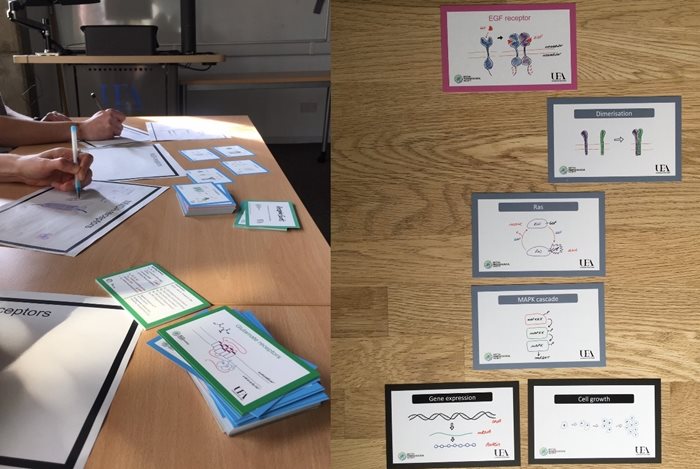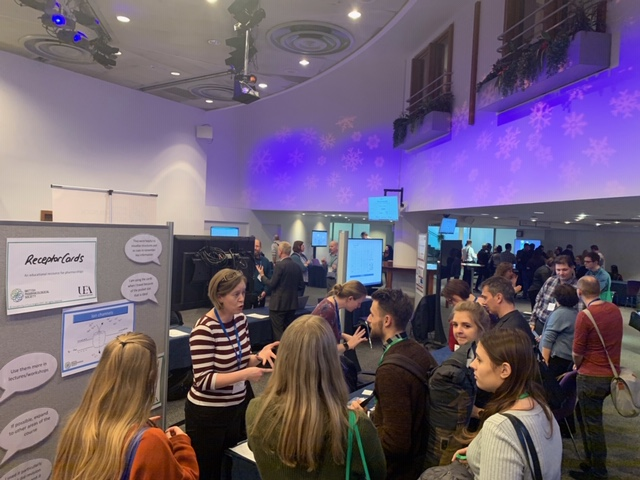As lecturers in pharmacology at the University of East Anglia (UEA), we know that teaching the fundamental concepts of receptors, characteristics of receptor families and initiation of cell-signalling pathways is critical for students studying programs such as BSc Pharmacology and Drug Discovery or MPharm degree courses. We find that some students love this area of cell biology, but others struggle with its complexity. Also, there is a whole new scientific language with many acronyms that students need to get to grips with to succeed. Remembering the different types of receptors and which G protein they couple to, and then which second messengers are generated, can be tricky. Other than textbooks and the online Guide to Pharmacology, there are few educational resources to help students with this task.
How did we come up with the idea of ReceptorCards?
We came up with the idea of making a pack of summary cards while preparing workshop questions about receptors and cell-signalling pathways. We wanted the students to be able to map out a pathway on the table in front of them, starting with the receptor at the cell membrane, coupling to the signalling proteins and then to second messengers inside the cell. We realised we could also add how each pathway controls a cellular response, thus linking the receptor to response pathway knowledge together. And the idea for ReceptorCards was born!
Development
We applied for a British Pharmacological Society (BPS) teaching award in summer 2017, outlining our idea for ReceptorCards. With that funding we employed two pharmacy students as interns for 6 weeks to help with design and content gathering. It really became a partnership of ideas between us educators and the students, who had already been through the struggle of learning.
We wanted something bright, visually appealing and informative, so we decided to colour-code the six families of receptors: GPCRs, ion channels, transporters, enzyme-linked receptors, enzymes, nuclear receptors. Each family contains important example receptors that we teach in our modules. The front of each card has a hand-drawn picture of the receptor (drawn by Leanne). The back of each card explains the receptor signals, key pharmacological information on important agonists/antagonists and a little about structure and expression. Pictures along the bottom of the card highlight the key organs/tissues where the receptors are expressed.
The packs also contain SignallingCards. There is one card for each of the major signalling proteins and second messenger molecules (e.g. cyclic AMP, Gαs, protein kinase A). On the back of each of these cards is a list of questions based on a ‘who am I?’ quiz, an idea that came directly from our student designers. We think this will be useful for students to test their knowledge during revision time.
Using ReceptorCards at UEA
After first launching the cards in October 2017 to our pharmacology students, in October 2018 we distributed them to both pharmacology and pharmacy students. UEA pharmacology lecturers try to refer to the cards in their lectures and we use them in various workshops, where the main goal is to help the students visualise signalling pathways.

Students designing their own ReceptorCards in a workshop (left) and using the cards to map out a cell signaling pathway (right)
Presenting ReceptorCards at Pharmacology 2018 and 2019
We presented the ReceptorCards during the education workshop at Pharmacology 2018 to interest from both students and educators. We have been gathering feedback from our students at UEA on their use of the cards. Many of the students like their size and ease of use while travelling and found them to be useful revision aids. In December 2019, we returned to the education workshop to showcase the cards, with the exciting news that the cards would be available for purchase in 2020.

Talking to students and educators during our education workshop demonstration stall at Pharmacology 2019
ReceptorCards are available for sale!
With further support from another BPS teaching award in 2019, we were able to launch ReceptorCards packs for sale, allowing all students studying pharmacology access to this resource. Packs can be purchased by visiting www.uea.ac.uk/pharmacy/receptorcards. The cost of each pack (currently £13 plus postage & packaging) covers printing costs for 80 cards on special, never-tear material. We do not make any profit from sales.
Get involved
We are keen to hear from you! Are you an educator interested in using this resource? We can provide a custom quote for a bulk batch of cards for your students. We would also be delighted to deliver a seminar/workshop introducing the ReceptorCards and to share our experience of using this resource with you and your students (from October 2020 onwards).
Find out more about applying for a BPS teaching award.
Comments
If you are a British Pharmacological Society member, please
sign in to post comments.